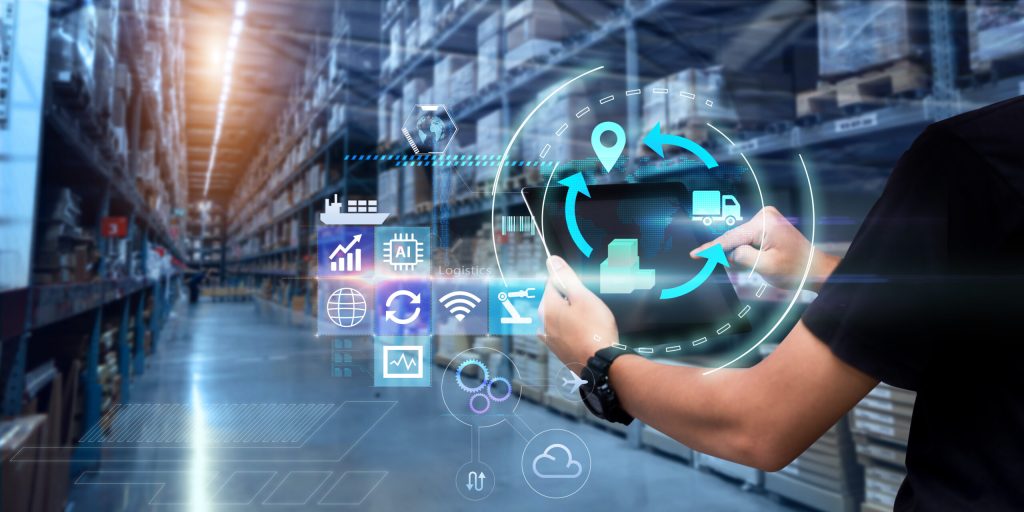Supply chain management (SCM) is one of the most critical aspects of modern business. From raw materials to finished products, the flow of goods across borders and industries is a complex, multi-step process that involves numerous stakeholders, including suppliers, manufacturers, distributors, logistics providers, and retailers. As the world becomes more interconnected, businesses are increasingly relying on global supply chains to meet customer demands.
However, despite the critical importance of supply chains, they face a range of issues, such as inefficiency, lack of transparency, fraud, and poor data management. These problems are particularly prevalent in global logistics, where the movement of goods is often fragmented, opaque, and prone to delays.
Blockchain technology, known for its ability to create secure, transparent, and immutable records, has the potential to revolutionize supply chain management by addressing many of the issues that plague traditional systems. But how exactly can blockchain improve trust, transparency, and efficiency in global logistics? Can it truly transform the way we manage the complex web of supply chains around the world?
In this article, we will explore how blockchain can be used to transform supply chain management, improve logistics, and solve the persistent issue of trust in the global marketplace.
Challenges in Current Supply Chain Management
Before understanding how blockchain can help, let’s take a look at some of the key challenges that affect global supply chains and logistics today.
1. Lack of Transparency
One of the primary issues in traditional supply chain management is transparency. As goods move from one supplier to another, information about their status, quality, origin, and journey is often fragmented and siloed across various parties. In many cases, stakeholders do not have real-time access to accurate data, making it difficult to track the origin and movement of products.
For example, a retailer may not have access to information about a product’s provenance (its origin, conditions during production, and how it was transported) unless it is provided by the supplier, which can lead to information gaps or even misrepresentation. This lack of transparency creates inefficiencies and opens the door for fraud and mismanagement.
2. Counterfeiting and Fraud
Counterfeit goods are a massive problem, especially in industries such as luxury goods, pharmaceuticals, and electronics. Fraudulent practices, including mislabeling, substitution of goods, and the counterfeiting of products, are common in supply chains, costing companies billions of dollars every year.
Without a reliable way to verify the authenticity of goods, businesses are vulnerable to counterfeit products being mixed in with genuine ones, leading to consumer distrust and reputation damage.
3. Inefficient Tracking and Slow Processes
Global logistics often involve multiple steps and stakeholders, including manufacturers, distributors, customs authorities, freight forwarders, and retailers. Traditional systems for tracking goods are often slow and inefficient. The documentation process can involve manual entries, paperwork, and multiple systems that are not well integrated. This inefficiency leads to delays, errors, and costly disruptions, especially when goods are being moved across international borders.
In addition, traditional systems may lack real-time visibility, meaning businesses cannot track their goods accurately. Delays in tracking shipments, miscommunication between partners, and inaccurate inventory management can all lead to increased costs, delays, and customer dissatisfaction.
4. High Costs and Increased Risk
Supply chains typically involve multiple intermediaries (e.g., banks, customs officials, shipping agents) who charge fees for their services. The more intermediaries involved, the higher the cost of logistics. Moreover, these intermediaries often perform redundant tasks and are prone to errors, increasing operational costs and risks in global trade.
The risks involved in international logistics include customs delays, lost goods, damaged products, and even theft. Ensuring that each intermediary is trustworthy and performing their duties efficiently requires oversight, but this can be difficult due to the decentralized and fragmented nature of global supply chains.
How Blockchain Can Transform Supply Chain Management
Blockchain technology offers several key features—such as decentralization, transparency, immutability, and security—that can solve many of the challenges in supply chain management. Let’s explore how blockchain addresses these issues and helps transform the way supply chains operate.
1. Decentralized and Transparent Record-Keeping
Blockchain’s core feature is its decentralized nature. In a traditional supply chain, data is often stored in centralized systems controlled by different parties (e.g., suppliers, distributors, and logistics providers). This means that data can be manipulated, delayed, or lost as it passes from one party to the next.
With blockchain, all transactions and records are stored on a distributed ledger, which is publicly accessible (though encrypted and permissioned for privacy and security). Each participant in the supply chain has access to the same version of the data, and any changes made to the data are immediately visible to all parties.
For example, if a shipment of goods passes through several stages—manufacturing, transportation, customs, etc.—each event is recorded on the blockchain. Once a transaction is added to the ledger, it is immutable, meaning that no one can alter or delete the record. This provides full transparency about the product’s journey, reducing the chances of fraud and ensuring that all stakeholders can access the same, reliable information in real-time.
2. Enhanced Tracking and Provenance of Goods
Blockchain makes it possible to track the provenance of goods throughout their lifecycle, from raw materials to finished products. Each time a good changes hands or undergoes a new process (e.g., transportation, quality checks, packaging), a record is created on the blockchain, providing an unbroken chain of custody.
In industries like food, pharmaceuticals, and luxury goods, where tracking the authenticity and safety of products is critical, blockchain can be particularly useful. For example, in the food industry, blockchain can help track produce from the farm to the grocery store, ensuring that consumers know exactly where their food came from and whether it meets safety and quality standards.
Similarly, in pharmaceuticals, blockchain can help trace the origin of drugs, ensuring they are not counterfeit and that they have been stored and transported under the right conditions. This can reduce the risks of counterfeiting and fraud and help ensure product integrity.
3. Smart Contracts and Automation
One of the most powerful applications of blockchain in supply chains is the use of smart contracts. These are self-executing contracts with the terms of the agreement directly written into lines of code. When certain conditions are met, the smart contract automatically executes the next step in the supply chain without requiring human intervention.
For example, if a shipment arrives at a warehouse, a smart contract can automatically release payment to the supplier or initiate the next step in the distribution process. Smart contracts help automate processes, reduce human error, and ensure that all parties follow the agreed-upon terms.
This automation also reduces the need for intermediaries, which not only lowers costs but also speeds up the entire process, making the supply chain more efficient.

4. Reduced Costs and Increased Efficiency
Blockchain reduces the need for multiple intermediaries and manual processes, which can significantly reduce transaction fees and administrative costs. By automating processes and eliminating the need for paperwork, blockchain also speeds up data exchange and lowers operational costs.
For example, in cross-border trade, blockchain can help streamline customs clearance by automatically validating import/export documents and verifying compliance with regulations. This can reduce the time and costs associated with customs checks and delays.
In addition, the transparency and accuracy of blockchain reduce the risk of fraud and errors, minimizing the costs associated with lost or damaged goods, miscommunication, or the need for dispute resolution.
5. Trust and Reliability in the Global Supply Chain
Blockchain builds trust among supply chain participants. Since the data on the blockchain is visible, immutable, and auditable, all parties involved can trust that the information is accurate and has not been tampered with. This is particularly important in global logistics, where companies may not have direct relationships with all the partners involved in a supply chain.
By providing an immutable record of transactions and making it easier to verify the authenticity and origin of goods, blockchain can help build trust between producers, suppliers, logistics providers, and consumers.
6. Improving Sustainability and Ethical Practices
Blockchain can also improve the sustainability and ethics of supply chains. By providing transparent data about the entire lifecycle of a product, blockchain makes it easier for consumers and businesses to verify that products are ethically sourced and produced in sustainable ways.
For example, blockchain can be used to verify that products such as coffee, clothing, or electronics have been produced with fair labor practices and in compliance with environmental standards. This allows businesses to promote their sustainability efforts and build consumer trust in the ethical standards of their supply chains.
Real-World Blockchain Applications in Supply Chain Management
Several companies are already utilizing blockchain to transform their supply chain operations. Here are some notable examples:
1. IBM Food Trust
IBM Food Trust is a blockchain platform that connects different players in the food supply chain, allowing them to trace the journey of products from farm to table. By providing end-to-end visibility, the platform improves food safety, reduces waste, and helps ensure the quality and provenance of food products.
2. VeChain
VeChain is a blockchain-based supply chain platform that focuses on logistics and product provenance. By using blockchain and IoT devices, VeChain helps companies track the movement of goods and verify their authenticity. The platform is being used in industries such as automotive, luxury goods, and pharmaceuticals.
3. Maersk and IBM TradeLens
Maersk, one of the largest shipping companies in the world, has partnered with IBM to create TradeLens, a blockchain-based platform for the global supply chain. The platform provides real-time visibility into the movement of goods and enables better collaboration between shipping companies, ports, and customs authorities.
Conclusion: Blockchain’s Role in Revolutionizing Supply Chain Management
Blockchain technology has the potential to radically transform supply chain management by improving transparency, efficiency, security, and trust. Through its decentralized, immutable ledger, blockchain can help businesses solve many of the challenges they face, such as lack of transparency, fraud, inefficient tracking, and high costs.
By reducing intermediaries, improving data accuracy, and enabling real-time monitoring, blockchain can create a more efficient, secure, and trustworthy global supply chain ecosystem. As the technology continues to evolve, blockchain will play an increasingly important role in shaping the future of global logistics and supply chain management.

















































